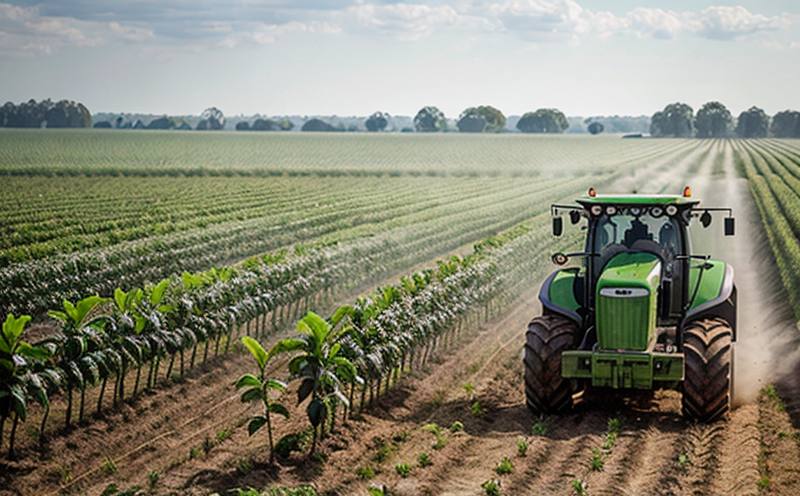EPA 8270 Semi Volatile Agricultural Chemical Testing
The EPA 8270 method is a widely recognized analytical technique used to detect and quantify semi-volatile agricultural chemical residues in environmental samples. This method is particularly important for ensuring the safety of crops, soil, water sources, and other environmental media from the adverse effects of agricultural chemicals.
The primary objective of this testing protocol is to identify the presence of pesticides, fungicides, herbicides, and other agricultural additives that may pose risks if they exceed safe concentration levels. Compliance with EPA 8270 helps regulatory bodies maintain a high standard of public health and environmental protection.
This method uses gas chromatography coupled with mass spectrometry (GC-MS) to achieve the necessary sensitivity and selectivity for detecting semi-volatile organic compounds (SVOCs). The testing process involves several critical steps, including sample collection, extraction, cleanup, derivatization, and finally, analysis by GC-MS. Each step is meticulously designed to ensure that only target analytes are detected without interference from other components.
Sample preparation for EPA 8270 typically includes the use of solid-phase microextraction (SPME) or liquid-liquid extraction techniques followed by clean-up procedures like solid-phase extraction (SPE). The samples are then derivatized to enhance their volatility and improve the detection limits. After this, the analytes are injected into a gas chromatograph for separation before being introduced into a mass spectrometer for identification.
The EPA 8270 method is based on well-established international standards such as ISO/IEC 17025, which ensures that testing laboratories meet stringent quality assurance and quality control requirements. Compliance with these standards guarantees accurate and reliable results. The method's scope includes the determination of over 300 pesticides and related compounds in various matrices like soil, water, plant tissues, and air.
One of the challenges associated with EPA 8270 is ensuring that all potential interferences are minimized during sample preparation and analysis. This requires thorough quality control measures to validate the accuracy and precision of the results. Additionally, maintaining consistent operating conditions across different laboratories is crucial for reproducibility.
The testing process can be time-consuming due to multiple steps involved in sample preparation and analysis. However, it is essential for ensuring that agricultural chemicals do not pose risks beyond acceptable limits set by regulatory bodies like the EPA. By adhering strictly to this method, labs contribute significantly towards protecting public health and preserving environmental quality.
- Sample Preparation: Includes extraction methods such as SPME or liquid-liquid extraction followed by cleanup steps using SPE.
- Derivatization: Enhances the volatility of analytes to improve detection limits in GC-MS analysis.
- Analytical Techniques: Utilizes gas chromatography (GC) coupled with mass spectrometry (MS) for separation and identification of semi-volatile organic compounds (SVOCs).
Applied Standards
The EPA 8270 method is aligned with various international standards aimed at ensuring accuracy, precision, and reliability in analytical chemistry. These include ISO/IEC 17025:2017 for laboratory accreditation, which mandates strict quality management systems to ensure consistent results.
Additionally, the method adheres to EPA's own guidelines for pesticide residue monitoring, emphasizing the importance of accurate detection and quantification of agricultural chemicals. Compliance with these standards is crucial not only for meeting regulatory requirements but also for gaining credibility among stakeholders within the industry.
The use of GC-MS in EPA 8270 ensures that even trace amounts of semi-volatile organic compounds can be detected, making it an essential tool for environmental monitoring and compliance. By following these standards rigorously, laboratories demonstrate their commitment to maintaining the highest level of scientific integrity and reliability.
For instance, ISO/IEC 17025:2017 emphasizes the need for continuous improvement in laboratory practices through regular audits and proficiency testing programs. These measures help identify areas where improvements are needed and ensure that all personnel involved in analytical work receive appropriate training.
The EPA's own guidelines further stress the importance of inter-laboratory comparisons to validate results across different facilities. This helps establish trust among customers who rely on accurate data for decision-making purposes related to environmental safety and agricultural practices.
Benefits
EPA 8270 semi-volatile agricultural chemical testing provides numerous benefits, particularly in terms of regulatory compliance and public health protection. By detecting trace amounts of pesticides, fungicides, herbicides, and other additives, this method helps ensure that food products meet safety standards set by governing bodies like the EPA.
Compliance with these regulations is not just a legal requirement but also crucial for maintaining consumer confidence in agricultural products. Regular testing ensures that no harmful residues exceed acceptable limits, thereby safeguarding both human health and ecosystems from potential harm.
The ability to detect even minute quantities of agricultural chemicals allows for early identification of any issues during production processes or post-harvest handling. This enables prompt corrective actions if necessary, preventing contamination incidents that could otherwise affect large-scale markets or populations.
Moreover, EPA 8270 supports sustainable farming practices by providing farmers with valuable information about the effectiveness and safety profile of different chemical inputs used in crop management. Such insights help optimize usage rates while minimizing environmental impact.
In addition to supporting regulatory compliance and public health protection, EPA 8270 semi-volatile agricultural chemical testing also contributes significantly to scientific research aimed at developing safer alternatives for pest control and plant growth enhancement. By continuously monitoring the presence of various compounds in agricultural environments, researchers can identify trends over time and inform policy decisions regarding sustainable agriculture.
Overall, EPA 8270 semi-volatile agricultural chemical testing plays a vital role in ensuring food safety, protecting ecosystems, supporting sustainable farming practices, and contributing to scientific advancements. Its rigorous application of international standards enhances confidence among stakeholders while promoting responsible use of agricultural chemicals.





